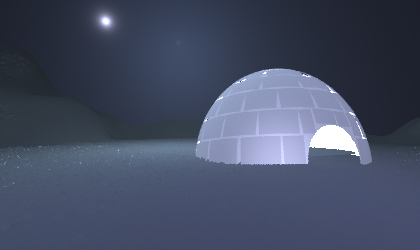
Night Based Modeling of Igloo
|
Syed Irfan Raza Zaidi |
Syed Farhan Raza Zaidi |

Rendered Image
.
Indirect Illumination
Indirect Illumination is simulated by Photon mapping i.e. by storing only those photons which have bounced atleast once from a surface. Diffuse properties were assigned to transluscent material which is only used for indirect illumination.
Indirect Lighting

Indirect + Non Transluscent Material Direct Lighting

Light Transport through Participating Media
We implemented ray marching algorithm and used Schlick approximation for phase function. We added an additional point light source which is used only by this ray marching algorithm to simulate the scattering in the atmosphere without adding illumination to any other object. The halo around the moon and scattering in the atmosphere is due to this effect.
Participating Media Lighting

Indirect + Participating Media Lighting

Transluscent Materials and Subsurface Light Transport
We created a new material type in lrt. This material type takes parameters Kd (diffuse parameter used for indirect illumination only), SigmaS (scattering coefficient), SigmaA (Absorption coefficient), Index (index of refraction used in calculation of Fresnel reflectance) and meancosine (this parameters control whether forward, backward or isotropic scattering occurs in the surface).
For creating the effect of transluscency we used a photon map which stores only those photons which have arrived there without any bounce. For efficiency reasons we stored the photons only on the materials which are transluscent. Whenever a ray hit a transluscent surface we estimated its BSSRDF (multiple scattering only) by the method given in [Jensen, H. W. al. etc., 2001] by using nearby photons in mean free path length distance. We have added one more parameter to photon map data structure i.e. normal direction at the surface where the photon strikes. This direction is used in Fresnel Transmittance calculations.
We used different transluscent material values for snow heightfield which is very dark transluscent material and allows very less amount of light to pass through it and igloo model material which allows more light to pass throught it to get our desired effect for each.
Transluscent

Transluscent + Media

Indirect + Transluscent Lighting

Final Rendered Image

Terrain Modeling
We created the heightfield using Terragen and then added some gaussian noise to it at selective places by noise brush in Wilbur. We exported Matlab format .mat file from Wilbur and used matlab to export the file in rib format.
Igloo Modeling
Igloo is modeled manually in the rib file and we used two layers of transluscent material. Outer layer is made by combining sphere patches with different transformations applied to each patch and Inner layer is made by a half sphere.
Modeling of Night Sky
We modeled the sky by encircling the whole scene boundary by a dark grey sphere.
Modelling of Moon
We modeled the moon by placing a small point light source very near to the sphere surface
Source Code : Use ./lrt test.rib snow_512c.rib
References :
Realistic Image Synthesis using Photon Mapping Henrik Wann Jensen ISBN: 1-56881-140-7. AK Peters, 2001
"A Rapid Hierarchical Rendering Technique for Translucent Materials" Henrik Wann Jensen and Juan Buhler, Siggraph 2002
"A Practical Model for Subsurface Light Transport" Henrik Wann Jensen, Steve
Marschner, Marc Levoy, and Pat Hanrahan
Proceedings of SIGGRAPH'2001
"Efficient Simulation of Light Transport in Scenes with Participating Media using Photon Maps" Henrik Wann Jensen and Per H. Christensen.Proceedings of SIGGRAPH'98, pages 311-320, July 1998
"A Practical Guide to Global Illumination using Photon Mapping" Henrik
Wann Jensen, Frank Suykens, and Per Christensen
SIGGRAPH'2001 Course
38